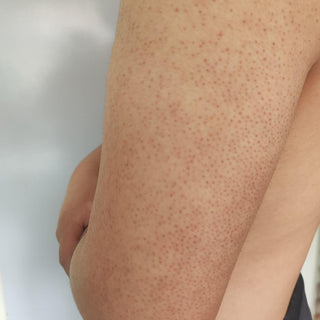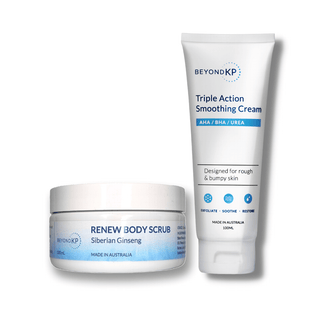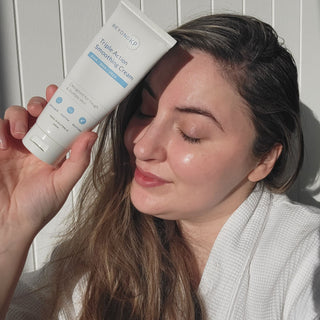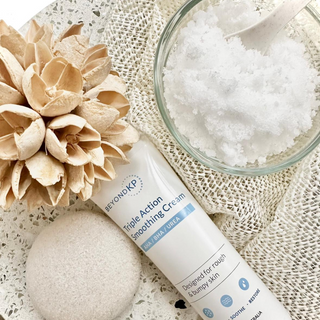Reading time: 6 minutes
Throughout my career as a pharmacist, and now with BeyondKP, it has always been my passion to help & support people with frustrating & persistent skin conditions.
This is something very personal to me - my own skin health journey has been marked by lifelong struggles with eczema, Keratosis Pilaris, and intense dry skin. I know all too well the embarassment and frustration these conditions can cause.
My goal is to address the common myths, stigmas and misconceptions about KP and provide effective guidance on treatment and management strategies - so that those who are impacted by KP can feel more comfortable and confident in their skin.
If you’re looking to get to the bottom of Keratosis Pilaris (aka KP or “Chicken Skin”) and work out what to do about it, then you’ve come to the right place! In this article, we’ll help you unpack what exactly KP is, what causes it, how to know if you have it, and what you can do about it!
Skip To...
What is Keratosis Pilaris?
Keratosis Pilaris (KP) is a common skin condition that typically presents as small, dry, rough bumps around hair follicles on the arms, legs, back, buttocks and even face. These little pimple-like bumps have a texture similar to sandpaper, and go by many names such as “chicken skin”, "strawberry skin”, “goosebump skin”, or simply just “KP”.

Seeing those bumps on your skin may be frustrating, but rest assured that KP is not a harmful skin condition and is not contagious. It’s actually very common, affecting approximately 40% of the adult population and up to 80% of teenagers.
Before we dive into understanding KP causes & symptoms, it’s worth noting that if you’re trying to work out if you have KP, we recommend a visit to your doctor or dermatologist for diagnosis, as there are a number of skin conditions that look quite similar.
What causes KP?
To understand KP, let’s take a close look at our skin, particularly the uppermost layer of our skin, known as the epidermis.
 The epidermis is made up of three different kinds of cells: keratin, melanin and Langerhan. Keratin is a protein that helps give our skin strength and protection against external factors, and is normally shed in a regular ongoing cycle. Melanin gives our skin colour and Langerhan prevents harmful germs from getting into our skin.
The epidermis is made up of three different kinds of cells: keratin, melanin and Langerhan. Keratin is a protein that helps give our skin strength and protection against external factors, and is normally shed in a regular ongoing cycle. Melanin gives our skin colour and Langerhan prevents harmful germs from getting into our skin.
Keratosis Pilaris occurs when excess keratin builds up around the hair follicles in our epidermis, resulting in many tiny raised bumps forming on the skin surface. It can also cause the hair to get trapped instead of growing outwards as normal.
Medical science hasn't yet proven exactly what triggers the excess keratin build-up. Studies so far indicate it could be caused by genetics - maybe you’ve noticed that others in your family also have KP. Many who suffer from conditions such as dry skin or eczema also appear to be more prone to KP, as well as people who live in drier environments with lower humidity.
What are the symptoms?
Keratosis Pilaris is usually also accompanied by these symptoms:
- Small raised bumps that are red, skin-coloured, or slightly discoloured
- Dry skin and mild itchiness around the affected area
- Slight inflammation and redness of the bumps - at times the entire affected area can appear red and angry
- Pigmentation and uneven skin tone can occur as our skin responds to inflammation by producing more melanin
- Scarring can result from picking at the bumps

Keratosis Pilaris is usually found on the upper arms, thighs, back, buttocks and even the cheeks and jawline (which can often be confused with rosacea).
Everyone can experience the symptoms differently. For example, people with fairer skin may experience bumps that are more red, while those with darker skin may notice discoloured spots or darker skin in the affected area (known as hyperpigmentation).
What triggers flare-ups?
You may notice that your KP symptoms vary in severity, with seemingly no rhyme or reason.
These flare-ups are often provoked by events that lead to skin dryness. Potential triggers for your flare-ups could include:
- Sweating which can result in further clogged pores
- Sudden change in climate, such as seasonal changes or moving from a humid, tropical environment to somewhere drier and colder
- Hormonal changes you might experience in pregnancy, puberty and menopause
- Harsh physical exfoliation
- Hot showers and baths
- Using strong cleansers or products with fragrance on the KP area
Is it KP or something else?
Different skin conditions can look pretty similar, so before trying to treat KP I strongly recommend seeing a doctor or dermatologist to confirm whether you have KP or something else.
A few conditions that are often confused with KP include:
Acne
Acne, a common skin condition we're all too familiar with, is caused by oil, bacteria and dead skin cells clogging the hair follicles, and often results in blackheads, whiteheads or pimples. 
Rosacea
Rosacea is persistent redness or flushing on the face, usually around the cheeks, nose, chin and forehead. It’s often confused with keratosis pilaris rubra faciei (KPRF or KP on the face).
This redness can appear as small, pus-filled bumps or pustules and tend to flare-up with heat, spicy foods, alcohol, stress, or hormonal changes.

Eczema
Even though both KP and eczema can cause itchy, dry, rough, bumpy skin, it’s the location of the rash and the nature of itchiness that helps to point out the difference. Eczema usually results in dry, itchy patches in spots like your hands, insides of the elbows, or behind the knees, although it can show up anywhere. It’s quite common for people who have KP to also have eczema, like myself.

Folliculitis
This is what happens when the hair follicles are inflamed - causing small, uniform red bumps that look like KP, or painful white-headed pimples. This is usually caused by an overgrowth of bacteria or fungus (Malassezia Folliculitis), but it can also be caused by physical irritation, such as from shaving or waxing.

How can I treat my Keratosis Pilaris?
Searching for a solution to KP can feel overwhelming at first, especially with so many options out there. If you’ve been trying to manage KP for a while, you might have tried many exfoliating solutions without achieving the results you’re looking for.
KP is a long-lasting skin condition, and, sadly, there isn’t a one-stop solution to just make it go away forever. You’ll see a lot of talk about scrubbing and exfoliating as a quick solution to KP’s visible signs. However, since KP has many different symptoms and our skin barrier is pretty delicate, it’s important to treat KP from multiple angles.
We recommend tackling KP with these goals in mind:
- Break down keratin build-up and smooth surface bumps
- Reduce skin inflammation, irritation & redness
- Repair & nourish the skin barrier
- Lessen dark patches and uneven skin tone
Break down keratin build-up and smooth surface bumps
Look for AHAs (glycolic or lactic acid) or BHAs (salicylic acid) which dissolve keratin build-up and smooth the skin surface, as well as urea, which can both break down keratin build-up as well as provide hydration to the skin.
💡Tip: Start with lower concentrations and gradually increase as your skin builds tolerance. Don’t forget to apply sunscreen in the morning, especially when using AHA-based products, as they can make your skin more sensitive to the sun.
Reduce skin inflammation, irritation & redness
To manage skin inflammation and irritation that often accompanies KP bumps and causes redness to appear, consider products with anti-inflammatory and soothing ingredients.
Ingredients such as aloe vera, colloidal oatmeal, ceramides, chamomile, zinc and niacinamide are renowned for their ability to reduce redness and calm irritated skin effectively.
Repair & nourish the skin barrier
After exfoliating, it’s crucial to replenish moisture and protect the fragile skin barrier. Look for moisturisers that are non-comedogenic (won't further block skin pores) and rich in ceramides, glycerine, hyaluronic acid, jojoba oil and squalane.
These ingredients mimic the skin's natural barrier and moisture components, providing targeted hydration and protective qualities for dry, eczema-prone, and KP skin.
💡Tip: Apply your moisturiser when your skin is still damp to lock in more hydration.
Lessen dark patches and uneven skin tone
For those dealing with hyperpigmentation, products containing salicylic acid, niacinamide, vitamin C, hydroquinone, azelaic acid or licorice root extract can help to even out skin tone. These ingredients work to inhibit melanin production and brighten dark spots.
💡Tip: Be patient, as it might take a few weeks to months to see noticeable results - consistent application of your treatment is key.
Check out our comprehensive treatment guide for help in choosing the right treatment option for your skin... and learning what to avoid.
When should I seek professional help?
You should always visit a doctor or dermatologist to confirm whether you actually have Keratosis Pilaris, or if you experience any of the following symptoms:
- Signs of skin infection, including: increased redness, swelling, warmth, pus or worsening pain in the KP area. If your skin is infected, you may require antibiotics.
- Severe scarring and open wounds from picking and scratching
- Hair loss to the affected areas
- Flare-ups during pregnancy or breastfeeding
- Significant emotional distress caused by KP: it may be beneficial to consult with a healthcare professional if KP disrupts your self-esteem or affects your daily life.
If you have persistent and severe KP, a dermatologist consultation is worth your while. They may recommend prescription-strength chemical exfoliant or suggest laser therapy to reduce redness and improve skin texture. To get the most out of a consultation, keep a diary of your symptoms and any products you’ve used; this can be valuable information in determining the most suitable treatment plan.
We're here to help...
So there you have it… your introduction to KP! If you found that useful, you might want to try our comprehensive treatment guide as your next stop.





